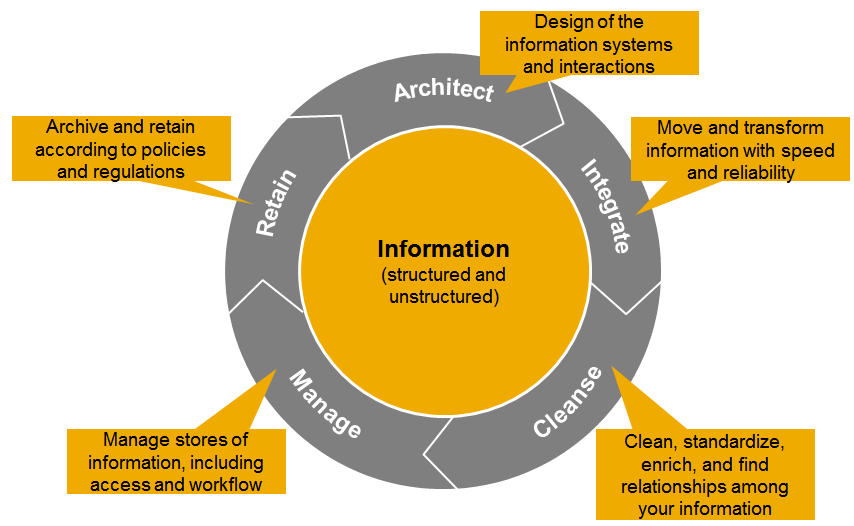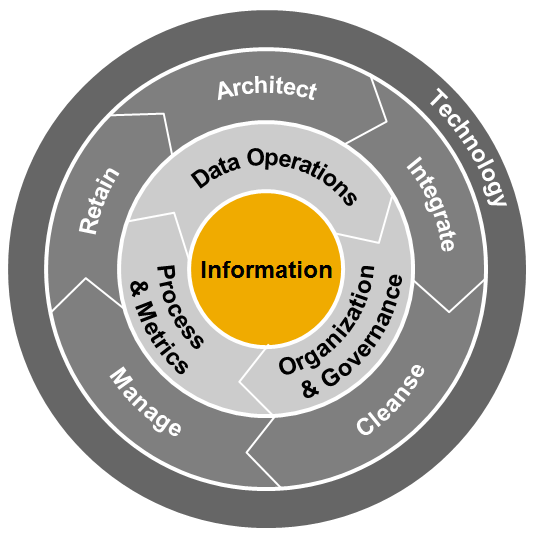
- SAP Community
- Products and Technology
- Enterprise Resource Planning
- ERP Blogs by SAP
- New Information Governance Model from SAP
- Subscribe to RSS Feed
- Mark as New
- Mark as Read
- Bookmark
- Subscribe
- Printer Friendly Page
- Report Inappropriate Content
Have you struggled to explain the fuzzy notion of information governance to your company? I have sat with many customers trying to do just that. The conversation seems to get bogged down between translating business language to IT language to business process language to LOB language…it goes on and on.
To help you, SAP is rolling out its new information governance model. This model not only helps explain the technical capabilities, but also the softer capabilities required to establish an information governance discipline.

This is our new information governance model. The intent is to use the Architect to Retain wheel that you have seen from us, and add some of the softer capabilities that you need to make information governance successful.
Note that these capabilities apply whether you are talking about master data, transactional data, or content.
Which of these activities are taking place that your company? Do you share tools? Do you share org structure/reporting? Do you share resources? Are you aligned in planning?
Hopefully, you are answering YES to many of these questions. The more times you can answer YES, the closer your organization is to understanding that information is a strategic asset across all of these activities, and sharing the org, resourcing, tools, etc. will make you better, faster, and smarter for future initiatives.

The new part of the information governance model is these softer capabilities in the lighter gray. The capabilities apply to every piece of the wheel.
Which of these softer capabilities are taking place that your company? Do you have committed resources? Do you have performance accountability for data goals? Do you share tools?
Again, we hope you are answering YES to many of these questions. The point here is to realize that business and IT need to be aligned for each of these capabilities, which means you need solutions that can close the translation gap between business and IT. SAP does this by helping IT build a safe sandbox, and then opening up the activities that business can self-serve within that sandbox.

The last part of the model is final, dark gray ring. Technology. Of course, you need technology to support all of the pieces of the wheel. By re-using the technology, and using integrated technologies, across the use cases, you can be better, faster, and smarter in solving your problems. Technology can help you focus on new strategic use cases instead of just keeping the lights on.

Of course, we have solutions for every piece of this wheel. SAP Information Steward, Data Services and Data Quality, SAP Master Data Governance, Enterprise Content Management (SAP ECM), Information Lifecycle Management, and SAP PowerDesigner.
(here's a final, no-call-out version for you to use, too):

Please use this new information governance model in your company. And let us know how it goes!
Next step: Part II Self-assess your capabilities for executing on an Information Governance strategy. These assessment tools are used by SAP's own Data Management team, and have won them awards.
The final piece is Part II: Build an Information as an Asset Roadmap to highlight EIM strategy . Use the roadmap to highlight your strategic, multi-year approach to information.
You must be a registered user to add a comment. If you've already registered, sign in. Otherwise, register and sign in.
-
Artificial Intelligence (AI)
1 -
Business Trends
363 -
Business Trends
20 -
Customer COE Basics and Fundamentals
1 -
Digital Transformation with Cloud ERP (DT)
1 -
Event Information
461 -
Event Information
22 -
Expert Insights
114 -
Expert Insights
147 -
General
1 -
Governance and Organization
1 -
Introduction
1 -
Life at SAP
415 -
Life at SAP
2 -
Product Updates
4,687 -
Product Updates
199 -
Roadmap and Strategy
1 -
Technology Updates
1,502 -
Technology Updates
85
- Introducing the market standard of electronic invoicing for the United States in Enterprise Resource Planning Blogs by SAP
- What You Need to Know: Security and Compliance when Moving to a Cloud ERP Solution in Enterprise Resource Planning Blogs by SAP
- FAQ on Upgrading SAP S/4HANA Cloud Public Edition in Enterprise Resource Planning Blogs by SAP
- Futuristic Aerospace or Defense BTP Data Mesh Layer using Collibra, Next Labs ABAC/DAM, IAG and GRC in Enterprise Resource Planning Blogs by Members
- Five Key assessments for a Smooth ECC to S/4HANA Transformation in Enterprise Resource Planning Q&A
| User | Count |
|---|---|
| 5 | |
| 5 | |
| 4 | |
| 4 | |
| 4 | |
| 4 | |
| 4 | |
| 3 | |
| 3 | |
| 3 |